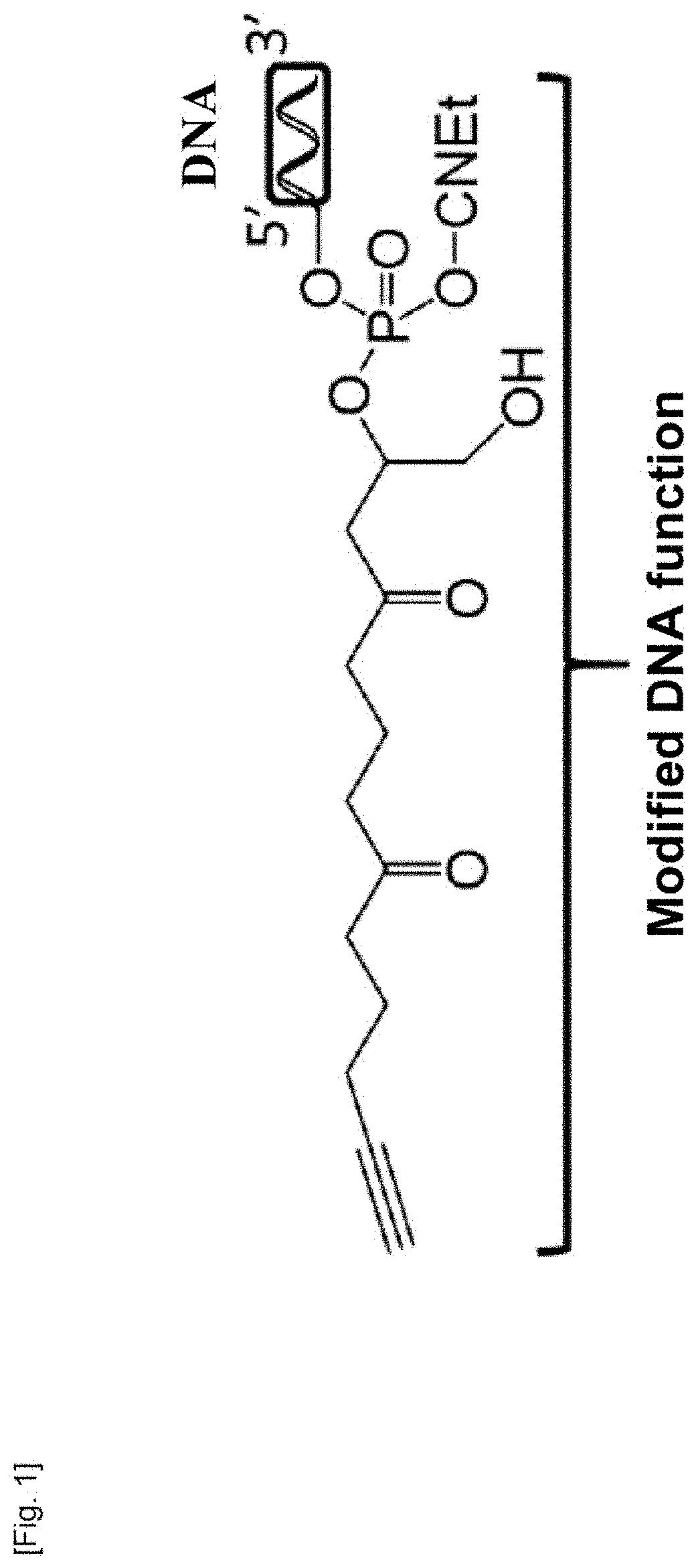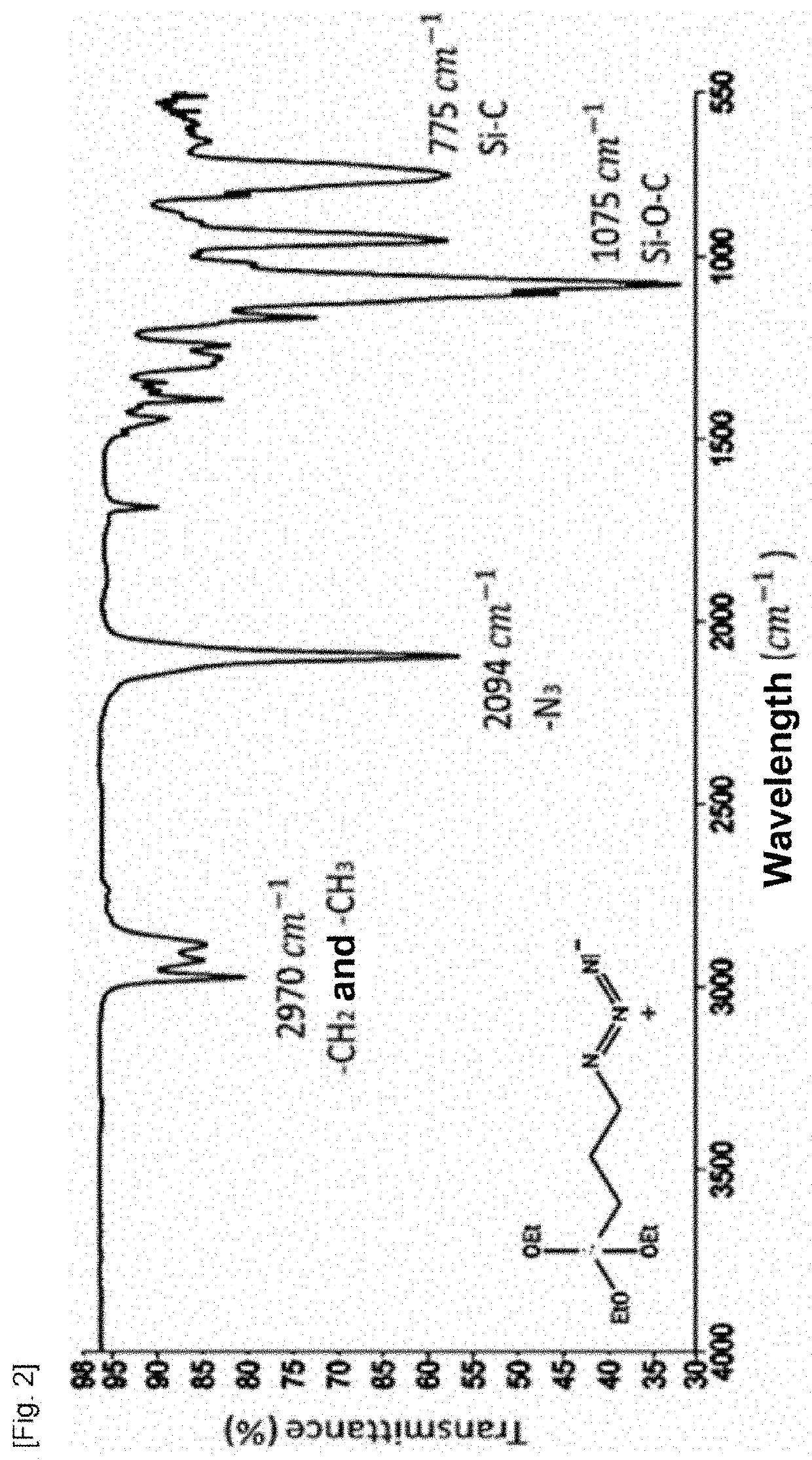Material for capturing circulating cells in the blood, method of preparation and use
a technology for circulating cells and blood, applied in the field of circulating cell capture materials in the blood, method of preparation and use, can solve the problems of poor prognosis, insufficient chemotherapy for cancer treatment, and risk for patients to develop metastases in other organs, so as to improve the effectiveness of chemotherapy and reduce the risk of metastasis formation
- Summary
- Abstract
- Description
- Claims
- Application Information
AI Technical Summary
Benefits of technology
Problems solved by technology
Method used
Image
Examples
example 1
Method of Grafting an Anti-MUC-1 Aptamer onto a Dense Alumina Ceramic
[0192]Example 1 illustrates the preparation method according to the invention in which the binding molecule is first bound to the alumina ceramic before a substituted anti-MUC-1 aptamer is bound to the binding molecule. All of the synthetic reactions are summarized in FIG. 3.
Step 1—Synthesis of the 3-azidopropyl) triethoxysilane Binding Molecule (AzPTES)
[0193]1.93 g of chlorosilane (8 mmol), 0.2 g of KI (1.2 mmol) and 1.56 g of NaN3 (24 mmol) are mixed in a 50 ml Schlenk tube. The system is placed under vacuum and then under an argon atmosphere and 10 ml of DMF (N,N-dimethylformamide) are introduced under argon. The reaction is started for 24 h at 80° C. and 330 rpm. The solution is then yellow. After 24 hours, the solution has turned white and has two phases. Once the medium has returned to ambient temperature, the solution is filtered through a Celite® 545 filter (approximately 1 cm) soaked in 15 ml of DMF on a N...
example 2
[0210]Example 1 was reiterated using an aptamer marked at its 3′ end by the FITC. The material thus prepared was observed under a confocal microscope. An unlabeled alumina ceramic material was also observed as a control: as may be seen in FIG. 4A, no fluorescence is visible on the surface of the material.
[0211]It was observed that the material prepared according to the process according to the invention was grafted homogeneously with the aptamer (FIG. 4B). A three-dimensional map was produced by scanning the grafted material of FIG. 4B with a laser over a thickness of 8 μm with a pitch of 0.8 μm, which corresponds to taking a confocal image every 0.8 μm. The digital compilation of these images provides the three-dimensional map shown in FIG. 4C. As this map shows, the material according to the invention is grafted with the aptamer labeled with FITC in a dense and homogeneous manner (FIG. 4C).
example 3
[0212]In vitro binding assays were performed on MDA MB231 breast cancer cells. MDA MB231 cells are epithelial cells derived from adenocarcinoma of the breast. MDA MB231 cells are cultured according to the supplier's instructions. The cells are then trypsinized, washed and centrifuged for 10 min at 1500 rpm. For the test, 20,000 cells are taken up in 500 μl of cell culture medium without fetal calf serum (FCS). Three conditions are tested:[0213]Negative control: culture medium (20 μl),[0214]FITC alone diluted in the culture medium (20 μl), or[0215]FITC-labeled aptamer in culture medium (20 μl).
The aptamer used is an aptamer specific for the MUC1 receptor and comprises 72 bases as follows:
(SEQ ID NO: 1)5′-GGGAGACAAGAATAAACGCTCAAGCAGTTGATCCTTTGGATACCCTGGTTCGACAGGAGGCTCACAACAGGC-3′
[0216]The aptamer is labeled with fluorescein isothiocyanate FITC at its 3′ end according to any technique well known to those skilled in the art.
[0217]The cells are then incubated for 1 hour at 37° C. and 5% ...
PUM
| Property | Measurement | Unit |
|---|---|---|
| volume | aaaaa | aaaaa |
| volume | aaaaa | aaaaa |
| volume | aaaaa | aaaaa |
Abstract
Description
Claims
Application Information
 Login to View More
Login to View More - R&D
- Intellectual Property
- Life Sciences
- Materials
- Tech Scout
- Unparalleled Data Quality
- Higher Quality Content
- 60% Fewer Hallucinations
Browse by: Latest US Patents, China's latest patents, Technical Efficacy Thesaurus, Application Domain, Technology Topic, Popular Technical Reports.
© 2025 PatSnap. All rights reserved.Legal|Privacy policy|Modern Slavery Act Transparency Statement|Sitemap|About US| Contact US: help@patsnap.com



